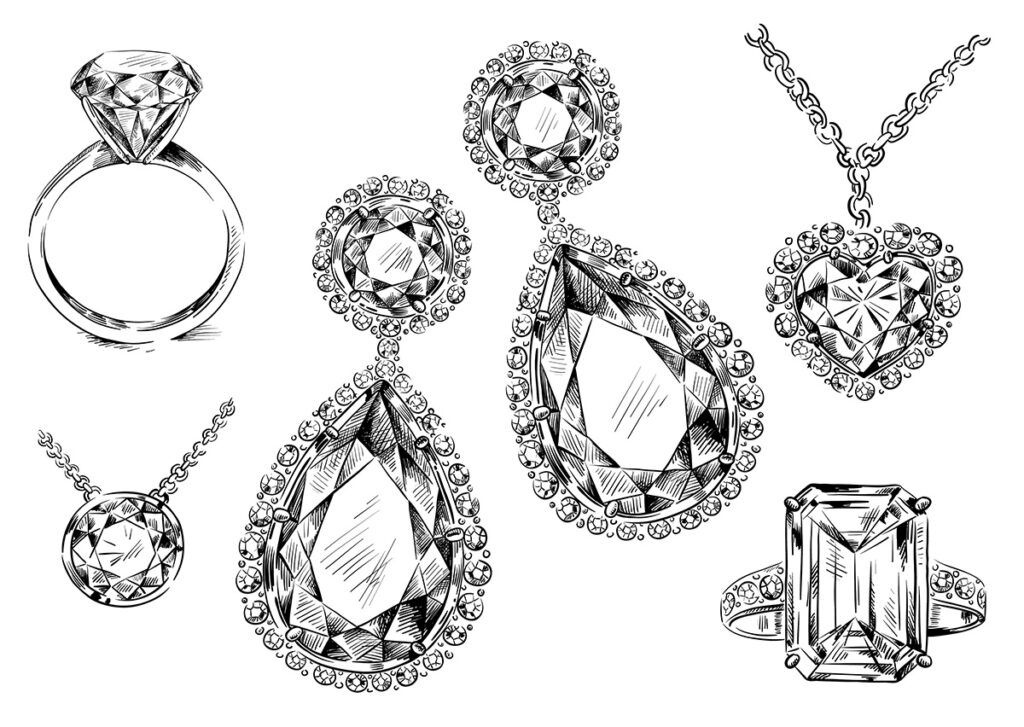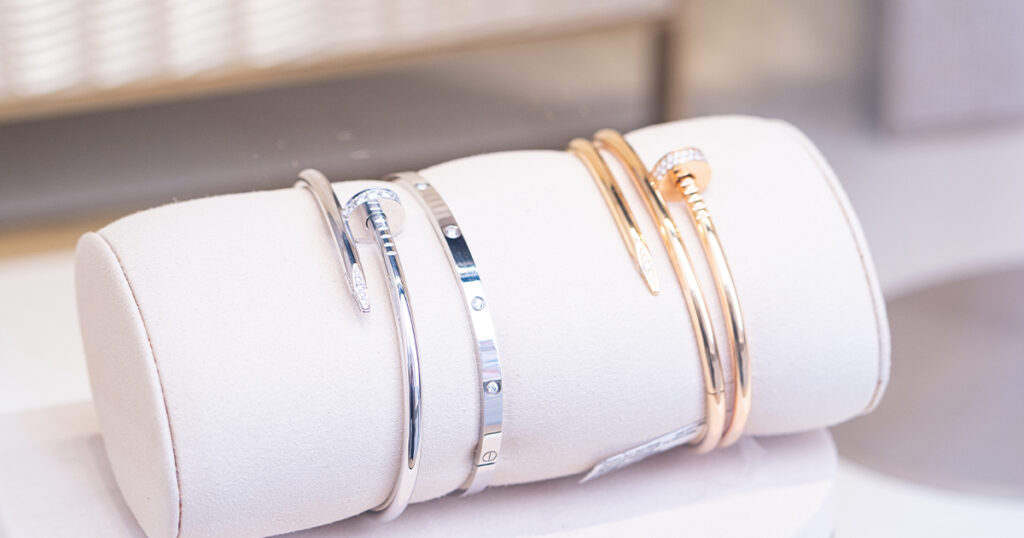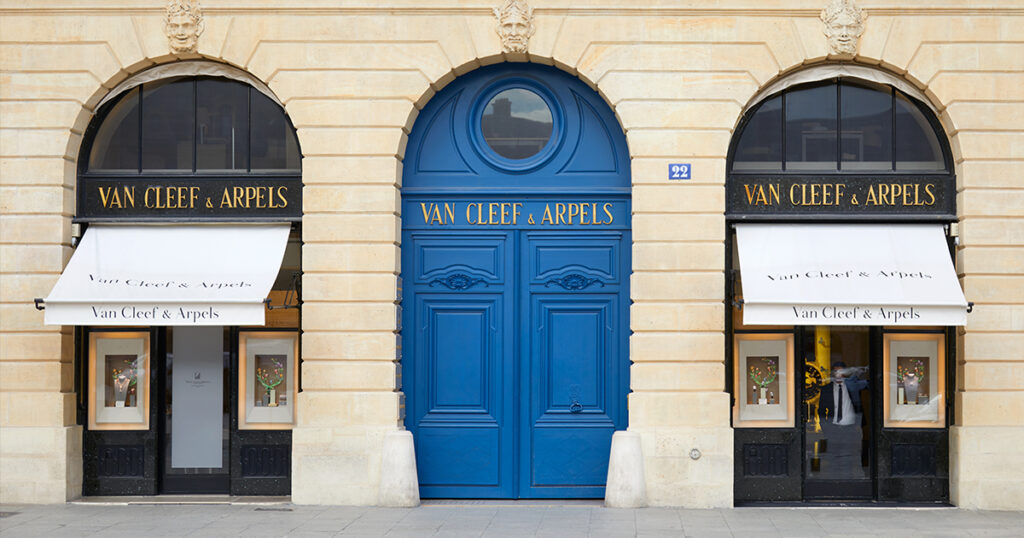
When it comes to jewelry, certain names bring with them an understanding of luxury. Pieces made by one of these iconic brands are automatically assumed to be designed with painstaking attention to detail and the finest craftsmanship, with a storied history that garners respect and admiration, even from those who don’t know anything about jewelry. So how did these jewelry houses reach the status they have today? What are the trademarks of design for each one? Let’s walk through some of these names and their history.

Tiffany & Co.
It seems like every person on the planet would be able to recognize the ‘Tiffany blue’ box as a symbol of luxury. Charles Lewis Tiffany founded the company in 1837, in New York City. Just a few years later they began marketing their products by mailing catalogues in their now trademark blue and became known as the ‘Blue Book Collection.’
Mr. Tiffany promoted his company as a destination for incredible jewelry by purchasing diamonds and jewelry abroad, including items from the French Crown Jewels and one of the world’s largest yellow diamonds, which he named the Tiffany Diamond. The firm pioneered the simple 6-prong setting for engagement rings, known as the Tiffany Setting.
In the 20th Century, the house hired several designers to mix up their design aesthetic. Tiffany & Co. is one of the only jewelry houses to allow (only a few) designers to sign the pieces they designed for Tiffany & Co.: Jean Schlumberger, Elsa Peretti, Paloma Picasso, and Frank Gehry.
Tiffany & Co. Today
Today, Tiffany & Co. remains the most well-known and well-respected American jewelry firm. Signature items include the ‘Bean’ and ‘Open Heart’ collections by Elsa Peretti, ‘X’ and ‘Bird on a Rock’ designs by Jean Schlumberger, the ‘Return to Tiffany’ collection inspired by dog tags, and the new ‘T’ collection. The company also produces fine home goods like frames, flatware, barware, and stationery. Tiffany & Co. continue to be the leader in responsibly sourced diamonds. Tracing the provenance of each diamond over 0.18 carat from the mine to the consumer.

Cartier
Founded in 1847 by Louis-Francois Cartier, this French house has remained at the forefront of fine jewelry generation after generation. Louis-Francois’ grandsons, Louis, Pierre, and Jacques, were responsible for establishing Cartier as a global luxury icon.
Louis ran the Paris store and designed several famous pieces, including mystery clocks (with transparent dials), the ‘Tutti Frutti’ collection of diamond Art Deco jewelry combined with carved colored gemstones sourced from India, and the ‘Santos’ watch- their first wristwatch for men. Pierre Cartier established the New York City store and Jacques oversaw their London operation.
Cartier is known for elegance. Cartier was at the forefront of reigning jewelry design styles. The delicate and feminine Garland Style at the beginning of the 20th century made possible with the implementation of platinum, the geometric designs of Art Deco with Oriental, Egyptian, and Indian influence, the introduction of the firm’s signature panther motif by Jeanne Toussaint (first commissioned for a piece in the 1940s by the Duchess of Windsor), and iconic designs by Aldo Cipullo from the 1970s that are still widely popular today- the ‘Juste un Clou’ and ‘Love’ bracelet collections.

Van Cleef & Arpels
Van Cleef & Arpels was formed with the marriage of two jewelry families. Alfred Van Cleef, a Dutch diamond cutter, married Estelle Arpels, whose father was a precious stones dealer.
Alfred partnered with his new father-in-law, Salomon Arpels, to open Van Cleef & Arpels in Paris in 1906. Producing fine jewelry with extremely high craftsmanship, they expanded and opened stores throughout France. In 1933, they patented the ‘Mystery Set’ technique, still a trademark of the brand today. It involves cutting gemstones to fit their exact location on the piece which slide onto metal tracks without any prongs showing. Only highly trained craftsmen can execute this technique.
Van Cleef & Arpels Collections
Grace Kelly was a long-time Van Cleef & Arpels client. She is the reason the firm was named the ‘Patented Supplier of the Principality of Monaco.’ Her timeless style was accentuated by Van Cleef & Arpels pearls and diamonds. She was an early devotee of the ‘Alhambra’ collection introduced in 1968. ‘Alhambra’ pieces feature quatrefoil motifs in gold or semi-precious stones and remain extremely popular today. Other iconic VCA motifs include ballerinas modeled after famous dancers and butterflies used in many forms.

Fabergé
Gustav Fabergé founded Fabergé in 1842 in St. Petersburg. His son, Peter Carl Fabergé took over the business in 1882. Peter Carl studied goldsmithing in France, England, and Germany and learned ancient techniques by repairing masterpieces in the Hermitage collection.
In 1885, the Russian emperor commissioned the firm to create an Easter egg for the empress, making Fabergé the ‘goldsmith by special appointment to the Imperial Crown.’ They were commissioned for another egg the next year. The projects continued, giving Fabergé creative control as long as the egg contained a surprise. By 1900, Peter Carl Fabergé was appointed a Knight of the Legion of Honour for his inventive designs and painstaking craftsmanship.
Fabergé Easter Eggs
The house of Fabergé is most known for the Easter eggs created for the Russian monarchs. These pieces were made with exquisite technical mastery, sophisticated guilloche enamel techniques, and incorporating fine diamonds and gemstones. The firm translated these elements into designs for other luxury items like snuff boxes, as well as jewelry.
After a tumultuous history with the Bolshevik Revolution and trademark and licensing agreements, the firm has been re-established in the 21st century with these same principles of design and craftsmanship.

Bvlgari
Silversmith Sotirio Bulgari established Bvlgari in Rome in 1884. His pieces were popular souvenirs for tourists visiting Italy from England on their Grand Tours. Sotirio’s sons Giorgio and Costantino joined the business and pivoted the firm’s focus from silver to gold and fine jewelry.
They created traditional pieces until the 1940s when the signature Bvlgari Serpenti designs emerged. The serpent continues to represent the brand today, with bold, coiling designs produced in many forms. From the 1950s onwards, Bvlgari has pushed the envelope with unique combinations of colored gemstones and the use of more unusual materials such as ancient coins, wood, steel, and porcelain.
The ’Monete’ collection incorporates ancient coins set in heavy gold jewelry and is extremely collectible and popular today, as well as the ‘Serpenti’ and ‘B.Zero 1’ collections. Much like the panther has come to symbolize Cartier, the snake symbolizes Bvlgari.

Iconic Jewelry Sources
Bennett, David & Daniela Mascetti, Understanding Jewellery, 2010.
Online timelines and articles directly from the houses.
Authored By:
Hana Thomson is a freelance jewelry writer and appraiser in the Ann Arbor area. She has worked at museums, auction houses, and in jewelry retail and production. With a Master’s degree in History of Jewelry Design from 1850-1950 from Parsons/Cooper-Hewitt in NYC and a Graduate Gemologist degree from GIA, she loves continuing to learn and research the stories behind jewelry, watches, and objects.